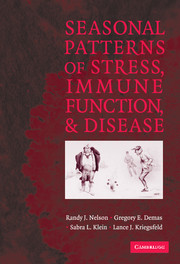Book contents
- Frontmatter
- Contents
- Acknowledgments
- Foreword
- Preface
- 1 Seasonality
- 2 Immune Function
- 3 Seasonal Fluctuations in Disease Prevalence
- 4 Seasonal Changes in Immune Function
- 5 Photoperiod, Melatonin, and Immunity
- 6 Energetics and Immune Function
- 7 Hormonal Influence on Immune Function
- 8 Clinical Significance of Seasonal Patterns of Immune Function and Disease
- References
- Index
6 - Energetics and Immune Function
Published online by Cambridge University Press: 11 November 2009
- Frontmatter
- Contents
- Acknowledgments
- Foreword
- Preface
- 1 Seasonality
- 2 Immune Function
- 3 Seasonal Fluctuations in Disease Prevalence
- 4 Seasonal Changes in Immune Function
- 5 Photoperiod, Melatonin, and Immunity
- 6 Energetics and Immune Function
- 7 Hormonal Influence on Immune Function
- 8 Clinical Significance of Seasonal Patterns of Immune Function and Disease
- References
- Index
Summary
In winter and spring the bowels are naturally the hottest, and the sleep most prolonged; at these seasons, then, the most sustenance is to be administered; for as the belly has then most innate heat, it stands in need of most food.
Hippocrates, ca. 400 B.C. AphorismsIntroduction
Animals require a relatively steady supply of energy to sustain biological functions. Although these energy demands are somewhat continual, both daily and seasonal fluctuations in energy requirements occur as physiological and behavioral activities wax and wane. Animals typically do not feed continuously to supply constant energy to cells; rather, adaptations have evolved to store and conserve energy. Eventually, however, the chronic need for energy depletes stores and requires animals to obtain food. In most habitats, significant daily and seasonal fluctuations in food availability occur. For example, outside of the tropics, food availability is generally low during winter, whereas thermogenic energy demands are typically high. Consequently, energy intake and energy expenditures are never perfectly balanced because of fluctuations in both energy requirements and energy availability.
Most animals restrict breeding to specific times of the year when food is abundant and survival and reproductive success are most likely. Inhibition of winter breeding is one of the central components of a suite of energy-saving adaptations evolved among nontropical animals (Goldman & Nelson 1993).
- Type
- Chapter
- Information
- Seasonal Patterns of Stress, Immune Function, and Disease , pp. 151 - 189Publisher: Cambridge University PressPrint publication year: 2002

